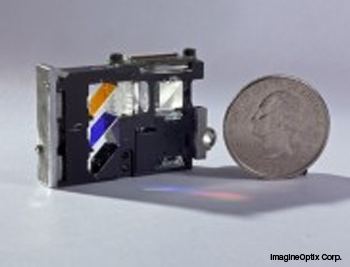
Prototype of an energy-efficient picoprojector that could be embedded in a smartphone or tablet device, next to a U.S. quarter coin.
A new type of polarization converter could make digital projectors and display systems, including “picoprojectors” for handheld devices, a lot more energy-efficient.
Researchers at North Carolina State University (NCSU) and ImagineOptix Corp. (Raleigh, N.C., U.S.A.) invented the conversion device, which consists of a liquid-crystal polarization grating and a louvered wave plate (Appl. Opt. 51, 4852). The team used the device in a prototype picoprojector, which realized nearly 90 percent efficiency in the conversion of unpolarized to polarized light.
The light sources behind most of today’s liquid-crystal displays and projectors emit unpolarized light. Traditional polarizers absorb or redirect photons at unwanted polarization angles, which wastes up to half of the light from the source.
Michael Escuti, associate professor of electrical and computer engineering at NCSU, and his colleagues developed a monolithic device of a liquid-crystal polarization grating, which produces orthogonally circularly polarized beams, and a louvered wave plate sandwiched between two microlens arrays. The louvers in the wave plate act as tiny quarter-wave plates that convert the beams from the grating to the same linear polarization. These components are laminated together to eliminate surface-air interfaces between them and to keep the tiny components aligned.
The researchers tested the converter with a broadband source of unpolarized white light. Over most of the visible range, the device demonstrated that it could polarize about 90 percent of the light within a divergence angle of 7 degrees—a substantially higher fraction than conventional polarizing beam splitters.
To demonstrate the efficiency of the polarization converter, Escuti’s team incorporated it into a prototype picoprojector with a volume of 6.3 cm3. The group’s projector had an overall efficacy of 12 lumens per watt, an overall brightness of 10 lumens and a contrast ratio of 200:1. The specifications compare favorably with those from a tiny projector in a commercially available camcorder.
